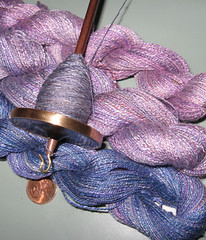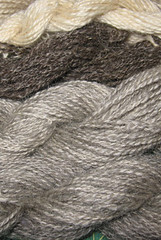Much The Same
Still spinning, still knitting, still weaving. The progress this week is not remarkable, even though there is another skein to add to the pile of silk:

There is a penny for scale this time, because when Lindsey saw the skeins she said: "I thought they would be bigger!" Nope. Small. But Mighty! About 150 yards per skein.
I am also spinning some wool/mohair blend for the next spindle bag:

Also on spindles, this time on the Viking Santas:

A few weeks ago I mentioned in this post about stranded yarns for pile, and Phreadde asked about Paternayan yarns. The yarns were developed in NYC in the early 1900's, by two brothers from Turkey, Harry and Karnick Paternayan. They were carpet repairmen, and needed a durable wool yarn in a wide range of colors. They used New Zealand wool (this was Phreadde's exact question: what breed of wool), and since NZ has an abundance of Romney sheep, I'd place a bet that is the wool in Paternayan yarns. The yarns are spun worsted, making them more durable, and as I mentioned in the previous blog post are stranded, in over 400 colors, making matching colors an easy task using either a color as is, or separating out the strands and mixing various values and hues to get an exact match.
Repairing carpets is an interesting topic: there is repair, restoration and conservation. Conservation is simply holding off further degradation. Whole carpets, as well as scraps and fragments, are often cleaned and either stored properly or perhaps sewn to a backing, preserving as much as possible the textile as it is presented. Museums do much of the conservation work, and most people don't have conserved textiles in their collections, they have repaired textiles (if not whole cloth !).
Repair is most common, and involves trying to fix and stabilize, as well as replace missing and worn areas. Since most workshop carpets sold for the last hundred-plus years have been woven of commercial wool, repair shops most often need commercial wool to do their work. This is where Paternayan yarn is valuable. I was introduced to it by the man I learned knotted pile from: he used Paternayan as his pile yarn to weave over 20 carpets in 20 years. The yarn has held up well: his first carpet shows no more wear than the most recent, and they have been on the floor and used for 20+ years.
Restoration involves returning a carpet to as-close-as-possible original condition. This is best done on valuable carpets, historically significant works, or, sometimes, by people with lots of money and no real concern for the ultimate worth of the carpet: they just want it restored. This is the most specialized of work, and often involves spinning wool to match the existing in grist, twist and breed, dyeing to match and making the most invisible of repairs which are expected to age along with the balance of the restored carpet.
As a spinner, when I started weaving knotted pile, I experimented with spinning yarns for my work. I used Paternayan as the model, and branched off in several directions, at first on the advice of lots of interested and some knowledgeable people. I have come back to the original stranded-model, as the previous post mentions, for many good and fun reasons.
So the yarn for the next spindle bag will also be stranded. I'm spinning both white and grey as the base yarns, and they will be dyed and sorted into color piles, and then woven held as one, I'm thinking two strands together, for a rich blend and depth of color not possible with just one strand.
This is the current spindle bag progress as of now:

See the glow of the shiny mohair yarns?
There is progress, but it all takes time. It moves slowly. So, eh, the current work indeed looks much the same as it did last week.

There is a penny for scale this time, because when Lindsey saw the skeins she said: "I thought they would be bigger!" Nope. Small. But Mighty! About 150 yards per skein.
I am also spinning some wool/mohair blend for the next spindle bag:

Also on spindles, this time on the Viking Santas:

A few weeks ago I mentioned in this post about stranded yarns for pile, and Phreadde asked about Paternayan yarns. The yarns were developed in NYC in the early 1900's, by two brothers from Turkey, Harry and Karnick Paternayan. They were carpet repairmen, and needed a durable wool yarn in a wide range of colors. They used New Zealand wool (this was Phreadde's exact question: what breed of wool), and since NZ has an abundance of Romney sheep, I'd place a bet that is the wool in Paternayan yarns. The yarns are spun worsted, making them more durable, and as I mentioned in the previous blog post are stranded, in over 400 colors, making matching colors an easy task using either a color as is, or separating out the strands and mixing various values and hues to get an exact match.
Repairing carpets is an interesting topic: there is repair, restoration and conservation. Conservation is simply holding off further degradation. Whole carpets, as well as scraps and fragments, are often cleaned and either stored properly or perhaps sewn to a backing, preserving as much as possible the textile as it is presented. Museums do much of the conservation work, and most people don't have conserved textiles in their collections, they have repaired textiles (if not whole cloth !).
Repair is most common, and involves trying to fix and stabilize, as well as replace missing and worn areas. Since most workshop carpets sold for the last hundred-plus years have been woven of commercial wool, repair shops most often need commercial wool to do their work. This is where Paternayan yarn is valuable. I was introduced to it by the man I learned knotted pile from: he used Paternayan as his pile yarn to weave over 20 carpets in 20 years. The yarn has held up well: his first carpet shows no more wear than the most recent, and they have been on the floor and used for 20+ years.
Restoration involves returning a carpet to as-close-as-possible original condition. This is best done on valuable carpets, historically significant works, or, sometimes, by people with lots of money and no real concern for the ultimate worth of the carpet: they just want it restored. This is the most specialized of work, and often involves spinning wool to match the existing in grist, twist and breed, dyeing to match and making the most invisible of repairs which are expected to age along with the balance of the restored carpet.
As a spinner, when I started weaving knotted pile, I experimented with spinning yarns for my work. I used Paternayan as the model, and branched off in several directions, at first on the advice of lots of interested and some knowledgeable people. I have come back to the original stranded-model, as the previous post mentions, for many good and fun reasons.
So the yarn for the next spindle bag will also be stranded. I'm spinning both white and grey as the base yarns, and they will be dyed and sorted into color piles, and then woven held as one, I'm thinking two strands together, for a rich blend and depth of color not possible with just one strand.
This is the current spindle bag progress as of now:

See the glow of the shiny mohair yarns?
There is progress, but it all takes time. It moves slowly. So, eh, the current work indeed looks much the same as it did last week.

4 Comments:
Oh, you ARE going to suck me into knotted pile bags, aren't you? (as I glance at the pile of Paternayan yarn three feet from a loom...)
Oy! Your posts never fail to entice me to do MORE - whether it be quantity produced in one discipline or learning more disciplines!
Lovely weaving.The colorful weave is lovely.Even the designs and the pattern is good.
heritage patchwork
This is exactly the info I had been searching for and I really appreciate your posting.
Post a Comment
<< Home